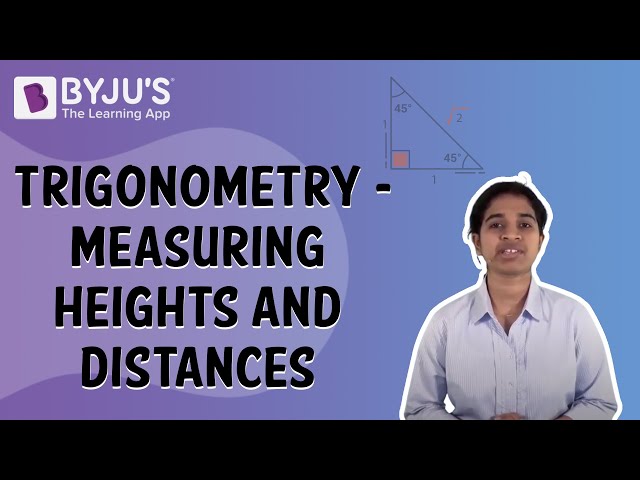Inverse Trigonometric Functions for Class 12 includes the major concepts related to the inverse of trigonometric functions, which will help the students score good marks in their examinations. The inverse trigonometric functions play an essential role in calculus, for they serve to define many integrals. The concepts of inverse trigonometric functions are also used in science and engineering.
In this chapter, you will learn about the restrictions on domains and ranges of trigonometric functions, which assure the existence of their inverses and observe their behaviour through graphical representations. Besides, students can also learn some elementary properties of inverse trigonometric functions.
Click here to get the Notes for all chapters of Class 12 Maths.
Inverse Trigonometric Functions Class 12 Concepts
The concepts covered in this Class 12 Chapter 2 Inverse Trigonometric Functions are:
- Introduction
- Basic Concepts
- Properties of Inverse Trigonometric Functions
Inverse Trigonometric Functions Class 12 Notes
Basics Concepts
Let’s recall the domain and range of trigonometric functions.
sine function, i.e., sine : R → [– 1, 1]
cosine function, i.e., cos : R → [– 1, 1]
tangent function, i.e., tan : R – { x : x = (2n + 1)π/2, n ∈ Z} →R
cotangent function, i.e., cot : R – { x : x = nπ, n ∈ Z} →R
secant function, i.e., sec : R – { x : x = (2n + 1)π/2, n ∈ Z} →R – (– 1, 1)
cosecant function, i.e., cosec : R – { x : x = nπ, n ∈ Z} →R – (– 1, 1)
| Read more: |
The below table gives the inverse trigonometric function (principal value branches) along with their domains and ranges.
| Function Name | Notation | Definition | Domain of x | Range |
| Arcsine or inverse sine | y = sin-1(x) | x = sin y | −1 ≤ x ≤ 1
i.e. [-1, 1] |
|
| Arccosine or inverse cosine | y = cos-1(x) | x = cos y | −1 ≤ x ≤ 1
i.e. [-1, 1] |
|
| Arctangent or
Inverse tangent |
y = tan-1(x) | x = tan y | For all real numbers |
|
| Arccotangent or
Inverse Cot |
y = cot-1(x) | x = cot y | For all real numbers |
|
| Arcsecant or
Inverse Secant |
y = sec-1(x) | x = sec y | x ≤ −1 or 1 ≤ x
R – (-1, 1) |
|
| Arccosecant | y = csc-1(x) | x = csc y | x ≤ −1 or 1 ≤ x
R – (-1, 1) |
|
Properties of Inverse Trigonometric Functions
Some properties of inverse trigonometric functions are listed below:
Set 1:
sin−1(1/x) = cosec−1x, x ≥ 1 or x ≤ −1
cos−1(1/x) = sec−1x, x ≥ 1 or x ≤ −1
tan−1(1/x) = cot–1x, x > 0
Set 2:
(i) sin–1(–x) = – sin–1 x, x ∈ [– 1, 1]
(ii) tan–1(–x) = – tan–1 x, x ∈ R
(iii) cosec–1(–x) = – cosec–1 x, | x | ≥ 1
Set 3:
(i) cos–1(–x) = π – cos–1 x, x ∈ [– 1, 1]
(ii) sec–1(–x) = π – sec–1 x, | x | ≥ 1
(iii) cot–1(–x) = π – cot–1 x, x ∈ R
Set 4:
(i) sin–1 x + cos–1 x = π/2, x ∈ [– 1, 1]
(ii) tan–1 x + cot–1 x = π/2, x ∈ R
(iii) cosec–1 x + sec–1 x = π/2, |x| ≥ 1
Set 5:

Set 6:

Click here to get more information about inverse trigonometric functions properties.
Video Lesson on Trigonometry

Inverse Trigonometric Functions Class 12 Questions
1. Find the principal value of tan-1(-√3).
2. Find the value of cos-1(1/2) + 2 sin-1(1/2).
3. Prove that tan-1(2/11) + tan-1(7/24) = tan-1(1/2).
4. Find the value of the expression tan[sin-1(3/5) + cot-1(3/2)]
5. Solve the equation: 2tan–1(cos x) = tan–1(2 cosec x)
Comments